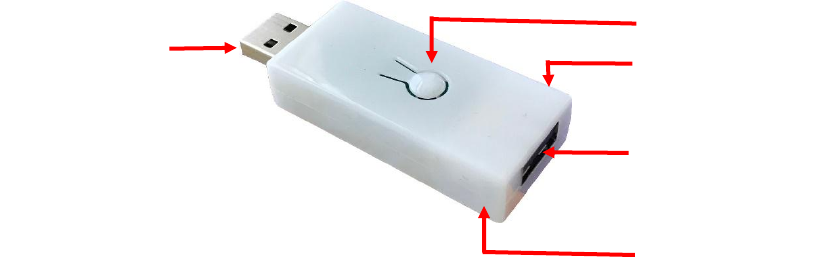Handheld Scientific BT-500 Bluetooth Adapter for Keyboard and Mouse User Manual
Handheld Scientific, Inc. Bluetooth Adapter for Keyboard and Mouse
user manual

Bluetooth Adapter for Keyboard and Mouse BT-500
User Manual v1.0
Key Features:
Based on Bluetooth 4.0 (Bluetooth Low Energy or BLE) with reduction in power consumption and fast connection time.
Works with all types of hosts including Mac OS, iPad, iPhone, Android tablets/smartphones, all versions of Windows and Linux as long as they
have Bluetooth 4.0.
Compatible with all types of USB keyboards including those with a built-in hub (e.g., Happy Hacking v1, DAS, Apple, Dell, IBM/Lenovo) and
keyboard/trackball combos (both the keyboard and trackball will work). For keyboards with a built-in hub, there can be only one other device
connected to it.
Most media keys on keyboard will work including volume +/-, mute, play/stop, previous/next, browser, calculator, home, help, sleep, search. The
handling of those keys varies greatly by the host. Programmable keys (for example, those marked as G1, G2, … on some Logitech keyboards) will
not work since they need customized device driver.
Many keyboard-like USB devices will work if they appear as keyboards in the operating system. Those include keypads, foot pedals, bar code
readers, magnetic strip readers, and PS2 to USB adapters. Most 2.4G wireless dongles (e.g., Logitech Unifying Adapter) will also work.
No keycode pairing: pairing just works without typing in any code.
Advanced Firmware features:
o Timers: periodically send a key, mouse movement or macro. There can be up to 4 timers.
o Macro: a sequence of keys or mouse movements which can be used in key mapping or timer.
o Key mappings: you can map any key to another key, to mouse movement or to a macro. There are built-in mappings to turn a Qwerty
keyboard to Dvorak or Colemak in one simple command.
1. LED indicators:
Green LED (for keyboard/mouse status)
Off when there is no devices connected. Fast blinking when device is plugged. Stopped blinking when device has been initialized
successfully. Otherwise keep blinking.
When there are key stokes or mouse movement, the LED would blink to indicate activities.
Blue LED (for Bluetooth connection status)
Blinks slowly (once per 2 seconds) when the adapter is connected to a host.
Blinks normal (once per second) when the adapter is not connected to a host.
Blinks fast (twice per second) when the adapter is in command mode.
2. When plugged into a laptop, the USB male port shows up as a composite keyboard and mouse device. Any keystrokes or mouse movements will be
output to this port.
3. If the adapter is not connected to a host, during the first 30 seconds after turning on, it will advertise its present and become available for pairing. Follow
the process below to pair:
Turn on the adapter with or without a keyboard connected. Blue LED should start flashing normally (once per second).
On the host, search for Bluetooth devices. The name of the adapter is ADAPTER_nnnn where nnnn is the last 4 digits of its MAC address.
When the host finds the adapter, select it and do “pair”. There is no need for any pairing code. If pairing succeeds, the adapter will then be
connected to the host and ready to be used. Blue LED flashes slowly.
Pairing is done only once. Next time when the adapter is turned on, it will connect to the paired host if it is available.
USB Device Port
For power and/or
Connecting to
computer
USB Host Port
For keyboard/mouse
Power/Mode Button
Green LED for
Device Status
Blue LED for
Bluetooth Status
BT-500
Bluetooth Adapter for Keyboard and Mouse
FCC ID: 2AQL7-BT-500
This device complies with Part 15 of the FCC Rules. Operation is subject to the
following two conditions:
(1) this device may not cause harmful interference, and (2) this device must
accept any interference received, including interference that may cause
undesired operation.
NOTE: This equipment has been tested and found to comply with the limits for a Class B digital device, pursuant to
part 15 of the FCC Rules. These limits are
designed to provide reasonable protection against harmful interference in a
residential installation. This equipment generates uses and can radiate radio
frequency energy and, if not installed and used in accordance with the instructions, may cause harmful interference to
radio communications. However, there is no guarantee that interference will not occur in a particular installation. If
this equipment does cause harmful interference to radio or television reception, which can be determined by turning
the equipment off and on, the user is encouraged to try to correct the interference by one or more of the following
measures:
- Reorient or relocate the receiving antenna.
- Increase the separation between the equipment and receiver.
-Connect the equipment into an outlet on a circuit different from that to which the receiver is connected.
-Consult the dealer or an experienced radio/TV technician for help
Changes or modifications not expressly approved by the party responsible for compliance could void the user's
authority to operate the equipment.
Responsible Party: Handheld Scientific, Inc.
Address: 5201 Great America Pkwy, Suite 320, Santa Clara, CA 95054, USA
Tel: 408-694-3782
Website: www.handheldsci.com